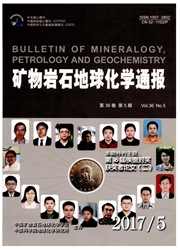

 中文摘要:
中文摘要:
用氧气燃烧弹将原油和干酪根氧化后,分析了δ^34S值,并与伴生的H2S、自生黄铁矿、硬石膏和重晶石脉δ^34S值进行了对比。结果显示,奥陶系原油相对贫硫,δ^34S值为13.6‰~19.9‰,接近于伴生的H2S和黄铁矿的δ^34S值15‰~18.5‰;石炭系-志留系原油相对富硫,δ^34S值为20‰~25.8‰,伴生黄铁矿的δ^34S值为9.5‰~34‰。有意义的是,奥陶系溶扩缝的硬石膏和重晶石脉δ^34S值为44.2‰~46.6‰,远高于显生宙的海水,被认为是热化学硫酸盐还原作用(TSR)的残余。研究还表明,原油中硫含量的增高可能与后期无机硫并入有关,而奥陶系低硫原油δ^34S值比寒武系源岩低2.5‰~7.5‰,可能来自寒武系干酪根的裂解作用。因而,低硫原油δ^34S值可用于油-源对比。
 英文摘要:
英文摘要:
Different sulfur-bearing species from Palaeozoic formation have been analyzed for δ^34S values aiming to addressing their origin and potential application in oil-source rock correlation. The results show that oils produced from the Ordovician are sulfur-poor and have δ^34S values from 13.6 to 19.9‰. The values are close to those of associated H2S gas and authigenic pyrite in the range from 15 to Silurian are sulfur-rich and have δ^34S values from 20‰ to 25. from 9.5‰ to 34‰. Interestingly, anhydrite and barite veins 18.5‰. Oils produced from the Carboniferous and 8‰ whilst associated pyrite has much wider values in enlarged fractures show much higher δ^34S values (from 44. 2‰ to 46.6‰ ) than those of Phanerozoic seawater, suggesting that the sulfates may have been the residue of thermochemical sulfate reduction (TSR) due to kinetic sulfur isotope fractionation. Small amount of pyrite was found to precipitate near TSR site in the Ordovician but did not inhibit TSR Proceeding, whilst much higher pyrite occurs in the overlying strata. Relationship between oil sulphur content and δ^34S value shows that TSR-derived inorganic sulfur may have been incorporated into petroleum. However, sulfur-poor oils have low δ^34S values distinct from inorganic sulfur. The oils show 2.5‰ to 7.5‰ lower than the Cambrian potential source rock, but much higher than the Upper Ordovican potential source rock, indicating that they may have derived from the Cambrian. Thus, it is reasonable to apply sulfur-poor oil δ^34S value to petroleum-source rock correlation.
 同期刊论文项目
同期刊论文项目
 同项目期刊论文
同项目期刊论文
 期刊信息
期刊信息
